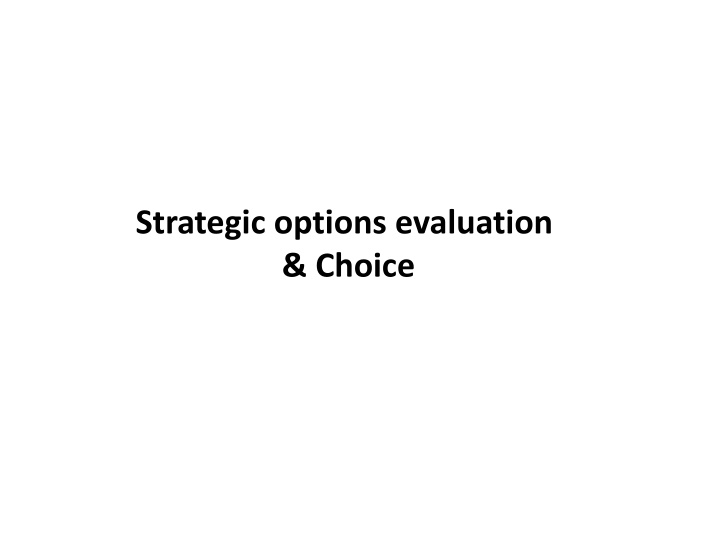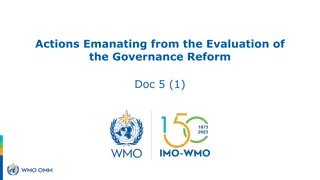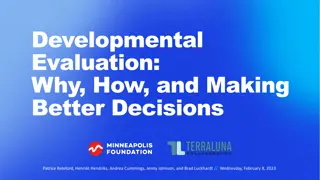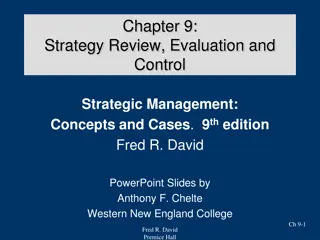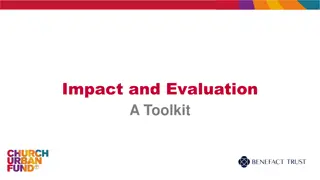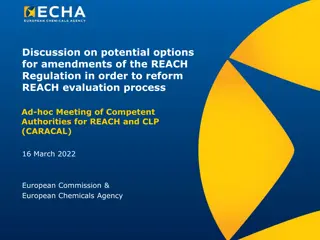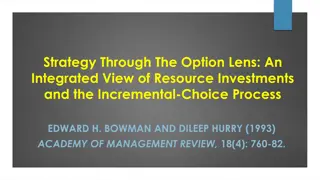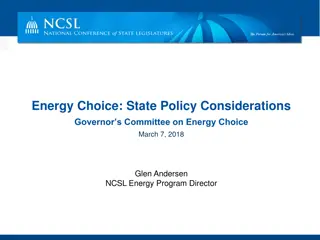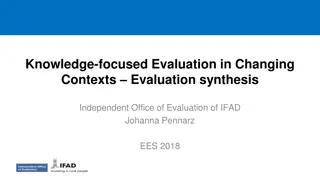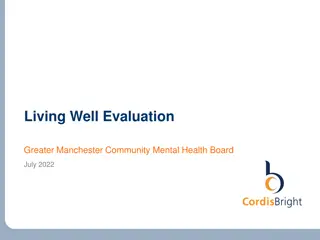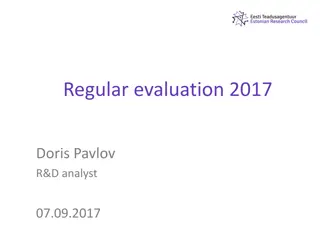Strategic Options Evaluation & Choice
This content discusses strategic options evaluation and choice in the realm of business strategy formulation, including analyzing internal and external factors, exploring strategic alternatives such as market development and diversification, and matching key factors to formulate alternative strategies. It also delves into strategic alternative choice using the Johnson & Scholes SFA matrix and considers the financial implications of corporate strategic decisions.
Download Presentation

Please find below an Image/Link to download the presentation.
The content on the website is provided AS IS for your information and personal use only. It may not be sold, licensed, or shared on other websites without obtaining consent from the author.If you encounter any issues during the download, it is possible that the publisher has removed the file from their server.
You are allowed to download the files provided on this website for personal or commercial use, subject to the condition that they are used lawfully. All files are the property of their respective owners.
The content on the website is provided AS IS for your information and personal use only. It may not be sold, licensed, or shared on other websites without obtaining consent from the author.
E N D
Presentation Transcript
Strategic options evaluation & Choice
Strategy-Formulation Analytical Framework Internal Factor Evaluation Matrix (IFE) Stage 1: The Input Stage Competitive Profiling External Factor Evaluation Matrix (EFE) Note: EFE and CP form external and IFE from internal (assessment)
Strategic alternatives Market development Retrenchment Concentric diversification Horizontal diversification Conglomerate diversification Liquidation Joint ventures Mergers & Acquisitions Market penetration Product development Forward integration Backward integration Horizontal integration Concentric diversification
Market option matrix and Expansion method matrix Market penetration Product development Market development Diversification Related Unrelated Corporate strategic options Company Outside Inside Mergers & Acquisition Joint venture Alliances Franchises Mergers & Acquisition Joint venture Alliances Franchises Licensing Internal development Home country Geographical location Exporting Overseas office Overseas manufacture Multinational operation Global operation International
Matching Key Factors to Formulate Alternative Strategies Key Internal Factor Key External Factor Resultant Strategy 20% annual growth in the cell phone industry (opportunity) Excess working capacity (strength) + = Acquire Cellfone, Inc. Exit of two major foreign competitors from the industry (opportunity) Insufficient capacity (weakness) Pursue horizontal integration by buying competitor's facilities + = Develop new products or remodified the existing carbonated drink as lifestyle products Increasing middle class and people become or health conscious Strong R&D (strength) + = Getting in to international market Existing market become or matured Market and brand leadership + = 5
Strategic alternative choice Johnson & Scholes SFA matrix Suitability Feasibility Acceptability
Financial Implication of corporate strategic decisions
Corporate Strategic Decision 1. Growth decision Source: Ansoff Matrix (Igo Ansoff)
Governance issue Vs Ownership Control
Financial Feasibility Evaluating the financial feasibility of such a decision will ensure that share holders money are invested in a profitable investment opportunity.
How to evaluate the corporate strategic decisions Discounted Cash Flow Methods Net Present Value (NPV) Internal Rate of Return (IRR) Non-Discounted Cash Flow Methods Payback Method Accounting Rate of Return
Projections This is the most crucial part of the long term investment decision evaluation. Accurately forecast the cost and the revenue for given period will have significant impact to the decision.
Assume that your company management is planning to put up a 200 rooms hotel in Trincomalee which will require initial capital outlay USD 500 million. Project the possible cash flows for next five years and what factors should be considered in the determination of the cash flows.
Discounted Cash Flow Methods NPV - the sum of discounted future cash flows less the initial cost IRR - the discount rate where NPV = 0
Net Present Value (NPV) NPV = + + C3 C2 (1 + r)2 C1 (1 + r)1 - C0 (1 + r)3 Initial Cost Discounted cash flows C1, C2, C3 = the project cash flows, r = discount rate (related to risk of the project) C0 = initial cost
Investment Decisions The board of directors of Magoo plc. is considering investing in a new machine that is expected to have a three year life and will cost 80,000. The machine is used to produce a good that is expected to have the following cash flows over the three years of the machine s life - Year 1 = 30,000; Year 2 = 50,000; Year 3 = 40,000. Cost of capital is 8% Should it purchase the machine?
Fundamental Rule of Finance/Financial Economics A capital investment decision is only worthwhile if it adds value. Thus, invest only in projects with a positive net present value
Student Activity You are the financial manager advising the board of Alpha plc. on potential investment projects and have the choice between two projects of the same risk classification whose cash flows are given below: Cash flow of Project X Cash flow of Project Y Given that the firm expects to obtain a 10% return on projects of this level of risk, provide a recommendation to the board on the viability of the two projects Year 0 -120,000 -80,000 1 20,000 40,000 2 60,000 40,000 3 100,000 30,000
INTERNAL RATE OF RETURN (IRR) Also based on Discounted Cash Flow, but calculates the discount rate that will give a Net Present Value of zero. This also represents the return that the project is giving on the original investment, expressed in DCF terms. The simplest way is to use trial and error - trying different rates until the correct rate is found. But this is laborious. There is a formula, using linear interpolation. Projects should be accepted if their IRR is greater than the cost of capital or hurdle rate.
IRR Interpolation method N ( ) = + L IRR L H L N N L H o Where: o o o L is the lowest discount rate H is the higher discount rate NL is the NPV of the lower rate NH is the NPV of the higher rate
NPV and IRR Gullane plc. are considering investing in a new machine that will cost 1 million. They estimate the machine will lead to an increase cash flow for the next three years of 500,000 in year 1, 600,000 in year 2, and 400,000 in year 3. Given that Gullane plc. determine that the risk-adjusted cost of capital is 10%, calculate the Net Present Value of the machine and recommend whether to ahead with the investment or not Calculate the Internal Rate of Return of the machine
Internal Rate of Return Decision Rules If k > r reject. If the opportunity cost of capital (k) is greater than the internal rate of return (r) on a project then the investor is better served by not going ahead with the project and using the money to the best alternative use If k < r accept. Here, the project under consideration produces the same or higher yield than investment elsewhere for a similar risk level
Payback Consider Cash flows and NOT Profits Evaluation based on period of recovery of the initial investment ie. Number of years it takes to cover the cost of investment Firms should look for early payback of capital invested Decision criteria Compare target payback with actual payback If actual payback period < target payback - Accept project If actual payback period > target payback - Reject project
Discount factor Cost of capital of firm Minimum rate of return, the firm must earn on its investments Hence also the Required rate of return Also considered as Opportunity cost The required rate of return must cover, the cost of all long term sources of funds Computed as the Weighted average cost of capital
Cost of capital (COC) Cost of capital is the company cost of long term source of finance which is generally used to capitalized the asset. There are tow major sources of long term funds. Equity and Debt capital
Cost of Equity The most commonly accepted method for calculating cost of equity comes from the Nobel Prize-winning capital asset pricing model (CAPM): The cost of equity is expressed formulaically below: Re = rf+ (rm rf) * Where: Re = the required rate of return on equity rf= the risk free rate rm rf= the market risk premium = beta coefficient = unsystematic risk
Cost of debt Cost of debt is the interest paid to lenders Debt is tax shield and should be adjusted to derive the cost of debt net of tax Kd= I (1-Tax rate)
Weighted Average Cost Of Capital (WACC Weighted average cost of capital (WACC) is a calculation of a firm's cost of capital in which each category of capital is proportionately weighted. All capital sources - common stock, preferred stock, bonds and any other long-term debt - are included in a WACC calculation. All else equal, the WACC of a firm increases as the beta and rate of return on equity increases, as an increase in WACC notes a decrease in valuation and a higher risk.
WACC Where, WACC= KeVe + KdVd Ke=Cost of equity Ve=Value of equity Vd=Value debt Kd=Cost of debt Ve+Vd
Student Activity Ashanti plc., are considering an investment of USD 1.9 m to enter in to the north east region of Sri Lanka. The capital investment is expected to have equal lives of 3 years and the cash flows for each year is given below: Any capital expenditure project is evaluated at corporate WACC as a hurdle rate. First year of the project is exempted from tax and 10% is applied after that. Year 0 Year 01 Year 0 Year 01 Year 02 Year 02 Year 03 Year 03 Investment Investment Revenue Operational cost 1,900,000 1,900,000 Revenue 1,000,000 1,000,000 300,000 1,400,000 1,400,000 300,000 2,000,000 2,000,000 300,000 Operational cost 300,000 300,000 300,000 Ashanti plc has 10 million equity and 5 million debt. It has 10% pa interest payment commitment in its debt and shareholders require 14 % return on their investment. The corporation tax rate is 28%. You are required to evaluate the financial feasibility of the new expansion using NPV, IRR and the pay back period.
Stakeholder mapping: the power/interest matrix Source: Adapted from A. Mendelow, Proceedings of the Second International Conference on Information Systems, Cambridge, MA, 1986
